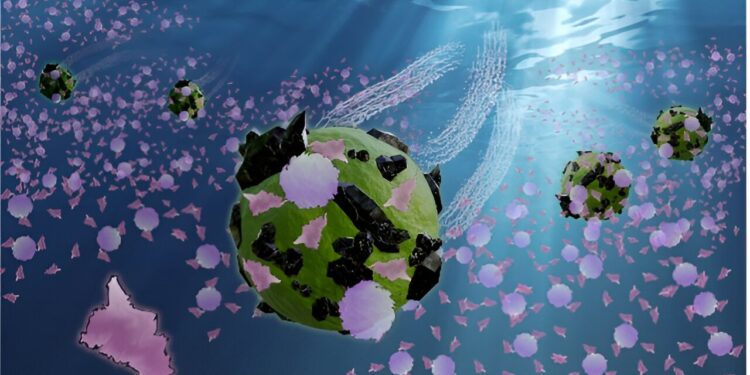Schematic illustration of micro/nanoplastics captured by MARs. Credit: Diogo Pinheiro.
Seas, oceans, rivers and other bodies of water on Earth have become increasingly polluted in recent decades, threatening the survival of many aquatic species. This pollution takes very diverse forms, including the proliferation of what we call micro and nanoplastics.
As their name suggests, micro- and nanoplastics are tiny, harmful particles that result from the disintegration of plastic waste released into water. These particles have been shown to disrupt aquatic ecosystems, for example by stunting the growth of organisms, reducing their food consumption and damaging fish habitats.
Designing efficient technologies to effectively remove these tiny particles is of utmost importance, as it could help protect endangered species and their natural environments. These technologies must be carefully designed to prevent further pollution and destruction; they must therefore be based on environmentally friendly materials.
Researchers from Brno University of Technology and Mender University in the Czech Republic recently developed biohybrid microrobots capable of removing micro- and nanoplastics from polluted water without causing additional pollution. These robots, presented in an article published in Advanced functional materialsintegrate biological materials, including algae, with environmentally friendly materials that respond to external magnetic fields.
“Members of our research group have studied the use of multilayer TiO2 microrobots for capturing nanoplastics,” Xia Peng, co-author of the paper, told Phys.org. “The initially proposed approach involved the incorporation of noble metals, such as platinum, to aid propulsion, thus contributing to a high cost. and the potential dangers associated with microrobots. To address this issue, we explored substituting expensive metals with a more economical, easily mass-produced alternative. »
Researchers have recently attempted to identify more affordable and environmentally friendly materials for their robots to overcome challenges encountered in their previous work. In particular, Peng began exploring the possibility of using algae cells, which could be easily introduced into marine environments without damaging them.

The fluorescent image composed of green-colored MAR and blue-colored nanoplastics after capture. Credit: Peng et al.
“The new robots we created, called magnetic algae robots (MAR), are made of a combination of algae and environmentally friendly magnetic nanoparticles,” Peng explained.
“These robots operate under the influence of an external magnetic field, allowing precise control of their movement. The negative surface charge of MARs is attributed to the presence of -COOH groups on the surface of algae cells. In contrast , the selected micro/nano “Plastics carry a positive surface charge. This positive-negative interaction facilitates electrostatic attraction, thereby promoting the targeted capture and removal of micro/nanoplastics by MARs.”
The unique composition of the robots created by the researchers makes them both non-polluting and sensitive to externally applied magnetic fields. This could allow them to sustainably recover nano- and micro-sized plastic particles from aquatic environments.
Peng and his colleagues evaluated their microrobots in a series of tests and found that they achieved remarkable results. In fact, they could be controlled remotely with a high level of precision, eliminating most of the small plastic particles present in the water tanks into which they were introduced.
“Our microrobots demonstrated remarkable removal efficiency, achieving a high success rate of 92% for nanoplastics and 70% for microplastics,” Peng said. “In the future, they could serve as a promising tool to actively eliminate plastic pollution from water bodies, contribute to environmental sanitation efforts, and mitigate the impact of plastic waste on aquatic ecosystems.”
In the future, MARs developed by this team of researchers could be tested and deployed in the sea and other water bodies, potentially contributing to the elimination of toxic plastic residues. Notably, the robots are made from affordable materials and scalable manufacturing processes, so they could be a cost-effective technology to combat pollution in aquatic environments.
“Our robots could potentially reduce the need for more resource-intensive and costly strategies currently used for plastic waste disposal,” Peng added.
“Further research could focus on studying the biocompatibility of MARs with aquatic ecosystems and assessing potential impacts on non-target organisms is crucial to understanding the environmental implications of their deployment. In addition, I would also like to explore how MARs can complement or be integrated with other technologies, such as sensors for real-time monitoring of plastic concentrations.
More information:
Xia Peng et al, Magnetically Driven Biohybrid Microrobots for Sustainable Removal of Micro/Nanoplastics from the Aquatic Environment, Advanced functional materials (2023). DOI: 10.1002/adfm.202307477
© 2023 Science X Network
Quote: Biohybrid microrobots could eliminate micro- and nano-plastics from aquatic environments (November 24, 2023) retrieved November 25, 2023 from
This document is subject to copyright. Apart from fair use for private study or research purposes, no part may be reproduced without written permission. The content is provided for information only.



